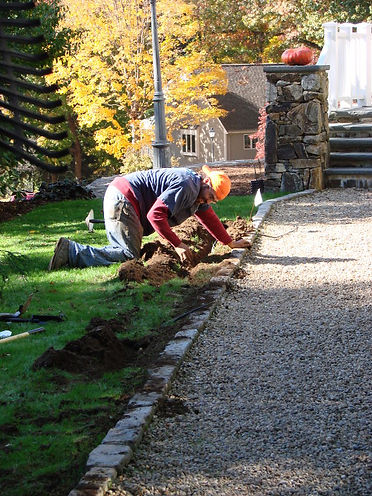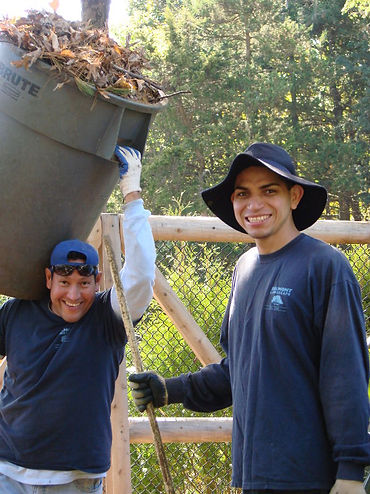Belmont Landscape & Tree
LANDSCAPE MAINTENANCE

We can bring out the natural beauty of your landscape with complete property maintenance.
-
Turf / Lawn management
-
Hand pruning and trimming of ornamental trees & shrubs
-
Flower pots and window boxes; perennials & annuals
-
Aerating and over-seeding
-
Mulches and soils
-
Scheduled maintenance
-
Spring and Fall cleanups
-
Organic and IPM fertilizer programs
-
Tick & Mosquitto spraying
-
Water feature maintenance
-
Yearly property maintenance contracts


Maintenance Tips:
Winter Damage:
For any of your ornamental plants or trees that have suffered some damage over the winter it is very important to start working on them right away. The earlier damaged plants are repaired or treated, the better chance they have of recovering.
We will come and assess the damage, and with the proper cabling, bracing or pruning most softwoods will easily re-conform to their prior shape and as the growing season begins your plants can make an amazing recovery.
Watering for a new seed lawn:
This may be the most important step. With the first watering, make sure that you apply enough water to wet the soil down to at least 6 to 8 inches. Apply the water gently so that you don't wash the seed away or create puddles.
You may have to water several times in short intervals until the bed is thoroughly wet. After that, water often enough to keep the top inch or so of the seedbed moist until the seed germinates. Remember, seeds get only one shot at germination. Let them dry out, and they're dead.
Sprinkle the seedbed lightly with a handheld hose several times a day — especially if it's hot or windy — to get even germination across the entire lawn. However, you don't want to overdo it. Too much water causes the seed to rot. Watch the color of the soil surface. As the soil dries, the surface becomes lighter in color. When you notice about half to two-thirds of the surface lightening up, it's about time to water.
Caring for your new lawn after germination:
As your new lawn becomes established, you can start easing up on the water, depending on the weather. If you continue your everyday watering routine, you're likely to overdo it and rot the young seedlings. Also, if the ground is too wet, you can inhibit root growth.
When you have a pretty even ground cover of new seedlings, try skipping a day of watering and see what happens. Watch the grass carefully. If the color starts to go from bright green to dull gray green, the grass needs water. You may have to water some quick-to-dry areas with a handheld hose. If the grass doesn't dry out, keep stretching the intervals between watering until you're on a schedule of once or twice a week, or as needed. When you do water, don't forget to water deeply, getting the moisture down 6 to 8 inches. Don't be a light-sprinkling fool — you end up with one lousy lawn.
But there's more to a new lawn than just watering. You need to mow the new lawn when it reaches 3 to 4 inches high, depending on the type of grass. Mow when the soil is on the dry side; otherwise, you might tear up the new turf.
You also need to make your first application of fertilizer about 4 to 6 weeks after germination.
Problems to avoid when watering a new seed lawn:
-
Over-watering that results in puddles on the surface. This can allow the seed to float around and the grass will not be evenly distributed.
-
Run-off and seed movement on sloping ground. It may be necessary to reduce the watering time and repeat more frequently.
-
Over-watering that allows the soil to get soggy and spongy. It can take a long time for some soils to dry out. Stay off of them if this happens.
-
Over-watering areas that are shaded and need less water while sunny areas need more water. Usually a problem with automatic sprinkler systems. If feasible, consider one cycle of automatic watering on the entire area, and a hand watering later, to cover just the more exposed areas.
-
Uneven watering due to sprinklers that are clogged, not adjusted or inadequately designed. Always check and do necessary corrections to a sprinkler system before the grass seed is sown.
-
Under-watering new grass seed, especially not often enough, due to any and all excuses. Remember, one mistake can mean you start all over again.
Instructions for Watering Newly Planted Shrubs
Rhododendrons and Azaleas
Although rhododendrons will not tolerate stagnant soil moisture, they are shallow rooted and the roots may dry out during the summer even though deeper rooted plants show no signs of drought stress. Therefore, rhododendrons should be well watered during the summer, especially the first year after planting when the roots have not yet gotten out of the original root ball and into the surrounding soil.
Rhododendron roots are very fine and it takes them longer to grow out into the surrounding soil than most other kinds of plants. Because of this, the newly planted rhododendron will get its water out of the original root ball and if this ball is allowed to dry out it is difficult to get it wet again. The soil around the planting hole can be wet, yet the plant root ball itself can be bone dry. This is an important point to remember. Often the only way to rewet a dry root ball is to place a dripping hose at the base of the trunk of the plant and let it run for several hours. Unless you have a very wet climate, doing this weekly in addition to the regular watering the plant gets during the first growing season will help get the plant off to a good start.
When a rhododendron is newly planted, the roots are only in the existing ball and have not had time to grow out into the surrounding soil. If the ball gets dry, water will not easily get back into it from the damp soil around it. Since no roots have had time to grow into the new soil, the plant is dry even though there is moisture near.
Some foliage droop is normal in dry weather, especially on warm afternoons, but when leaves still show signs of drooping in early morning, the plants are showing a need for water and should receive a good soaking. When air temperatures go above 95° F (or even lower for alpine types), rhododendrons and azaleas appreciate a misting to prevent desiccation of their foliage. In cold climates, watering or misting of foliage during warm days in the spring or on windy days when the roots are still frozen will help to keep rhododendrons in good condition.
A year-round mulch of some type of organic matter is desirable to conserve moisture and eliminate the need for cultivation. Because of their shallow roots, little or no cultivation should be done around rhododendrons. Weeds should be carefully pulled, or in extreme cases shaved off with a sharp hoe. A fairly deep mulch of leaves, pine needles, chips, bark or other organic material will practically eliminate weed growth. (Peat moss should not be used as a mulch because it sheds water when it dries out.) The coarser the mulch the better, as water and air are admitted while the mulch still retards evaporation by providing shade and reducing wind velocity over the roots. A mulch also helps to reduce temperature extremes in the root area.